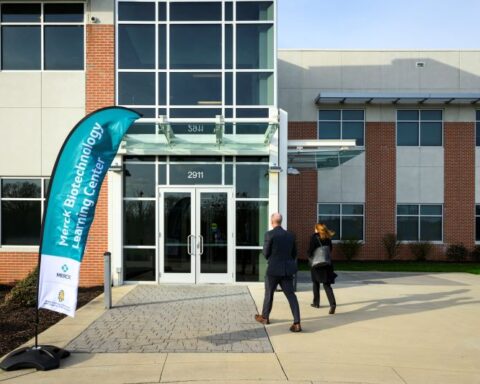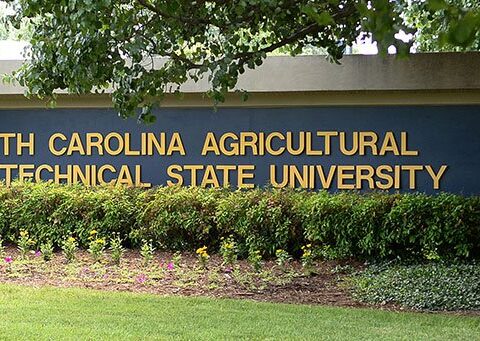By Jordan Howse
A leader in transportation technology and autonomous research, North Carolina Agricultural and Technical State University opened its rural test track and demonstrated its autonomous vehicles Tuesday, Nov. 1. One of the only rural tracks in the nation, the university unveiled a unique fleet of connected self-driving shuttles to be used for testing and developing advanced technologies for public transportation. Once testing is complete for the next phase, the vehicles will be cleared for deployment between the university’s campus and downtown Greensboro–allowing riders to experience leading autonomous innovation first-hand.
Leaders in local, state and federal transportation were invited to “test ride” the autonomous shuttles on the new track at Gateway Research Park’s North Campus. Testing the shuttles on the rural track gives research prominence to areas that are often neglected when considering public transportation.
This rural test track for autonomous vehicles and advanced set of self-driving shuttles will enable N.C. A&T researchers to develop revolutionary and equitable transportation solutions for low-demand rural areas by providing more efficient customer-focused transportation services via flexible routing and scheduling while reducing transportation costs because of smaller vehicle sizes and the adoption of ride-sharing strategies.
“It is exciting to see that talented students and researchers at N.C. A&T play such an important role in this transportation domain and push the boundaries of research, innovation, and advanced technologies in transportation domain and serve the society particularly the rural and underserved communities,” said Ali Karimoddini, Ph.D., director of NC-CAV Center of Excellence in Advanced Transportation Technology.
The developed fleet is comprised of a set of autonomous vehicles, including three low-speed self-driving shuttles, a high-speed self-driving van and two regular autonomous cars.
Each vehicle is classified at SAE autonomy Level 4, meaning they can perform all driving tasks under specific circumstances, and a human driver can override and take control of the car. Additionally, the cars are in compliance with the Federal Motor Vehicle Safety Standards. The shuttles’ maximum speed limit is 25 mph and, at this time, researchers have determined they can confidently drive them autonomously between 15 and 20 mph, depending on the terrain’s complexity.
This fleet allows researchers at A&T to test and develop different solutions for various domains ranging from university campuses, urban downtown areas, rural areas and highways. These vehicles will be connected to each other, to the cloud, and to the infrastructure to form connected autonomous microtransit vehicles (CAVs) to conduct interdisciplinary research leading to the development, implementation and validation of advanced transportation solutions.
Beyond the test track, researchers anticipate connecting A&T to downtown Greensboro as early as spring 2023. Although not far from each other, the two areas are considered disconnected and deploying these autonomous shuttles will make way for riders to travel to and from designated locations. To ensure safety, the vehicles must first undergo a period of socialization, which consists of “mapping” the route and deploying vehicles one by one. This allows the research team to identify potential challenges and make appropriate adjustments, as well as identify an appropriate route in collaboration with Greensboro Department of Transportation. Additionally, drivers will benefit from this deployment approach by becoming more acclimated to seeing the shuttles in transit and sharing the road comfortably and with confidence.
“The Federal Highway Administration is proud to support N.C. A&T’s work to develop this test track and bring the concept of connected and automated vehicles one step closer to market, especially for underserved and rural communities,” said FHWA Acting Administrator Stephanie Pollack. “The technology N.C. A&T is developing also has the potential to protect vulnerable road users – people who walk, bike or roll – by testing interactions with bike lanes, bus stops and more. These innovations are critical for ensuring the safety of all road users.”
Transportation research has a long history at A&T, beginning with the Transportation Institute’s establishment in 1970 and expansion to the Center for Advanced Transportation Mobility, which continues innovative research regarding vehicles, operators and infrastructure.
As a historically Black university, A&T has been a leader in preparing diverse populations to enter transportation-related professions. The university is the home to the first Summer Transportation Institute, now funded by FHWA, which has been running successfully for 30 years.
A&T is also home to the North Carolina Transportation Center of Excellence in Connected and Autonomous Vehicle Technology (NC-CAV), founded in 2019, and the Autonomous Cooperative Control of Emergent Systems of Systems Laboratory, or ACCESS Lab, founded in 2013. Both the NC-CAV and ACCESS have worked to model, analyze and improve effective solutions for complex transportation and autonomy problems in the way society moves. Karimoddini was joined by other faculty including Abdollah Homaifar, Ph.D., Leila Hashemi-Beni, Ph.D., John Kelly, Ph.D., and Steven Xiaochun Jiang, Ph.D., as well as collaborators from the University of North Carolina at Charlotte and North Carolina State University under the NC-CAV Center.
Throughout the history of autonomy at A&T, researchers have worked to expose undergraduate and graduate students to technology. Notably, A&T participated in the four-year international AutoDrive Challenge organized by SAE International and General Motors, and received several awards including the second place in the overall competition in 2019. Karimoddini was joined by other faculty advisors Sun Yi, Ph.D., Professor Daniel Acree, Younho Seong, Ph.D., and Balakrishna Gokaraju, Ph.D., who all helped the students leverage their disciplines to contribute to the team projects.
These advancements in autonomous technology have been made possible through federal, state and local partnerships and funding from the National Science Foundation, FHWA, the North Carolina Department of Transportation, Downtown Greensboro Inc. as well as industrial partners.





